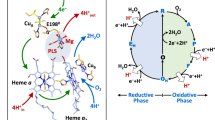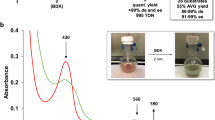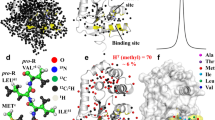Abstract
Small molecules such as NO, O2, CO or H2 are important biological ligands that bind to metalloproteins to function crucially in processes such as signal transduction, respiration and catalysis. A key issue for understanding the regulation of reaction mechanisms in these systems is whether ligands gain access to the binding sites through specific channels and docking sites, or by random diffusion through the protein matrix. A model system for studying this issue is myoglobin, a simple haem protein. Myoglobin has been studied extensively by spectroscopy, crystallography, computation and theory1,2,3,4,5,6,7,8,9,10,11. It serves as an aid to oxygen diffusion but also binds carbon monoxide, a byproduct of endogenous haem catabolism. Molecular dynamics simulations3,4,5, random mutagenesis6 and flash photolysis studies7,8,9,10 indicate that ligand migration occurs through a limited number of pathways involving docking sites. Here we report the 1.4 Å resolution crystal structure of a ligand-binding intermediate in carbonmonoxy myoglobin that may have far-reaching implications for understanding the dynamics of ligand binding and catalysis.
This is a preview of subscription content, access via your institution
Access options
Subscribe to this journal
Receive 51 print issues and online access
$199.00 per year
only $3.90 per issue
Buy this article
- Purchase on Springer Link
- Instant access to full article PDF
Prices may be subject to local taxes which are calculated during checkout


Similar content being viewed by others
References
Antonini, E. and Brunori, M. Hemoglobin and Myoglobin in their Reactions with Ligands (North-Holland Pub. Co., Amsterdam, 1971).
Vojtchovský, J. et al. Crystal structures of myoglobin-ligand complexes at near-atomic resolution. Biophys. J. 77, 2153– 2174 (1999).
Elber R. and Karplus, M. Multiple-conformational states of proteins: a molecular dynamics analysis of myoglobin. Science, 235, 318– 321 (1987).
Carlson, M. L., Regan, R. M & Gibson, Q. H. Distal cavity fluctuations in myoglobin: protein motion and ligand diffusion. Biochem. 35, 1125–1136 (1996).
Tilton, R. J. Jr et al. Computational studies of the interaction of myoglobin and xenon. J Mol. Biol, 192, 443– 456 (1986).
Huang, X. & Boxer, S. G. Discovery of new ligand-binding pathways in myoglobin by random mutagenesis. Nature Struct. Biol. 1, 226–229 ( 1994).
Austin, R. H. et al. Dynamics of ligand-binding to myoglobin. Biochem. 14, 5355–5373 ( 1975).
Scott, E. E. & Gibson, Q. H. Ligand migration in sperm whale myoglobin. Biochemistry 36, 11909– 11917 (1997).
McMahon, B. H. Energetics of protein fluctuations: Ligand binding to myoglobin and electron transfer in reaction center. Thesis, Univ. of Illinois at Urbana-Champaign, (1997).
Chu, K. et al. Light-induced and thermal relaxation in a protein. Phys. Rev. Lett. 74, 2607–2610 (1995).
Lim, M., Jackson, T. A. & Anfinrud, P. A. Ultrafast rotation and trapping of carbon monoxide dissociated from myoglobin. Nature Struct. Biol. 4, 209–214 (1997).
Alben, J. O. et al. Infrared spectroscopy of photodissociated myoglobin. Proc. Natl Acad. Sci. USA 79, 3744– 3748 (1982).
Powers, L. et al. Kinetic, structural and spectroscopic identification of geminate states of myoglobin: a ligand-binding site on the reaction pathway. Biochemistry 26, 4785–4796 (1987).
Tilton, R. F. Jr., Kuntz, I. D. Jr. & Petsko, G. A. Cavities in proteins: structure of a metmyoglobin-xenon complex solved to 1. 9 Å. Biochemistry 23, 2849– 2857 (1984).
Frauenfelder, H Sligar, S. G. & Wolynes, P. G. The energy landscapes and motions of proteins. Science 254, 1598–1603 ( 1991).
Schlichting, I., Berendzen, J., Phillips, G. N. Jr. & Sweet, R. M. Crystal structure of photolysed myoglobin. Nature, 371, 808–812 ( 1994).
Hartmann, H. et al. X-ray structure determination of a metastable state of carbonmonoxymyoglobin after photodissociation. Proc. Natl Acad. Sci. USA, 93, 7013–7016 (1996).
Teng, T. Y., Srajer, V. & Moffat, K. Photolysis-induced structural changes in single crystals of carbonmonoxymyoglobin at 40 K. Nature Struct. Biol, 1, 701–705 (1994).
Anfinrud, P., deVivie-Riedle, R. & Engel, V ., Ultrafast control and detection of molecular dynamics. Proc. Natl Acad. Sci. USA 96, 8328– 8329 (1999).
Gibson, Q. H., Regan, R., Elber, R., Olson, J. S. & Carver, T. E. Distal pocket residues affect picosecond ligand recombination in myoglobin: an experimental and molecular dynamics study of position 29 mutants. J. Biol. Chem. 267, 22022– 22034 (1992).
Quillin, M. L. et al. Structural and functional effects of the distal valine in myoglobin. J. Mol. Biol. 245, 416– 436 (1995).
Kachalova, G. S., Popov, A. N. & Bartunik, H. D. A steric mechanism for inhibition of CO binding to haem proteins. Science 284, 473– 476 (1999).
Abadan, Y. et al. Ligand binding to haem proteins V: light-induced relaxation in proximal mutants L89I and H97F of carbonmonoxymyoglobin. Biophys. J. 68, 2497–2504 ( 1995).
Ahmed, A. M. et al. Evidence for proximal control of ligand specificity in haemproteins: absorption and Raman studies of cryogenically trapped photoproducts of ligand bound myoglobins. Chem. Phys. 158, 329– 352 (1991).
Brunori, M. et al. Does picosecond protein dynamics have survival value? Trends Biochem. Sci. 24, 253–255 (1999).
Montet, Y. et al. Gas access to the active site of Ni-Fe hydrogenases probed by X-ray crystallography and molecular dynamics. Nature Struct. Biol. 4, 523–526 ( 1997).
Kabsch, W. Automatic processing of rotation diffraction data from crystals of originally unknown symmetry and cell constants. J. App. Crystallogr. 24, 795–800 (1993).
Brünger, A. T. X-PLOR: A System for Crystallography and NMR, Version 3. 1 (Yale Univ. Press, New Haven, 1992).
Jones, T. A. et al. Improved methods for building protein models in electron density maps and the location of errors in these models. Acta Crystallogr. A 47, 110–119 ( 1991).
Esnouf, R. A. An extensively modified version of MolScript that includes greatly enhanced coloring capabilities. J. Mol. Graphics 15, 132–134 (1997)
Acknowledgements
The work was generously supported by the Human Frontiers Science Program (to I.S. and J.B.), the Bundesministerium für Bildung und Forschung (to I.S.) and the Richard and Anne-Liese Gielen-Leyendecker-Stiftung (to I.S.). Beamline X12C is supported by the US Department of Energy Offices of Health and Environmental Research and of Basic Energy Sciences, and by the National Science Foundation. We are grateful to H. Frauenfelder for stimulating discussions, G. Holtermann for expert technical assistance, and R. S. Goody for continuous support and encouragement.
Author information
Authors and Affiliations
Corresponding author
Rights and permissions
About this article
Cite this article
Chu, K., Vojtchovský, J., McMahon, B. et al. Structure of a ligand-binding intermediate in wild-type carbonmonoxy myoglobin. Nature 403, 921–923 (2000). https://doi.org/10.1038/35002641
Received:
Accepted:
Issue Date:
DOI: https://doi.org/10.1038/35002641
This article is cited by
-
The Impact of Electron Correlation on Describing QM/MM Interactions in the Attendant Molecular Dynamics Simulations of CO in Myoglobin
Scientific Reports (2020)
-
Critical assessment of the FeC and CO bond strength in carboxymyoglobin: a QM/MM local vibrational mode study
Journal of Molecular Modeling (2020)
-
Structural stability of myoglobin and glycomyoglobin: a comparative molecular dynamics simulation study
Journal of Biological Physics (2015)
-
Carbon monoxide binding properties of domain-swapped dimeric myoglobin
JBIC Journal of Biological Inorganic Chemistry (2015)
-
Binding of Al(III)-tetracarboxyphthalocyanine to Hemoglobin and Myoglobin
The Protein Journal (2010)
Comments
By submitting a comment you agree to abide by our Terms and Community Guidelines. If you find something abusive or that does not comply with our terms or guidelines please flag it as inappropriate.



